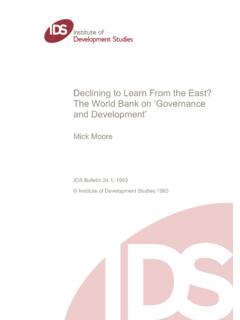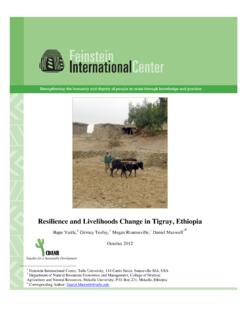Transcription of SUSTAINABLE RURAL LIVELIHOODS A FRAMEWORK FOR …
1 SUSTAINABLE RURAL LIVELIHOODSA FRAMEWORK FOR ANALYSISIDS WORKING PAPER 72 Ian ScoonesSUMMARYThe concept of SUSTAINABLE LIVELIHOODS is increasingly important in the development debate. This paperoutlines a FRAMEWORK for analysing SUSTAINABLE LIVELIHOODS , defined here in relation to five key FRAMEWORK shows how, in different contexts, SUSTAINABLE LIVELIHOODS are achieved through access to arange of livelihood resources (natural, economic, human and social capitals) which are combined in thepursuit of different livelihood strategies (agricultural intensification or extensification, livelihooddiversification and migration). Central to the FRAMEWORK is the analysis of the range of formal and informalorganisational and institutional factors that influence SUSTAINABLE livelihood outcomes. In conclusion, thepaper briefly considers some of the practical, methodological and operational implications of a sustainablelivelihoods concept of SUSTAINABLE RURAL LIVELIHOODS 1 is increasingly central to the debate about RURAL development,poverty reduction and environmental management.
2 But what does this new entry into the developmentlexicon actually mean? This short paper attempts to draw together some of the definitional issuessurrounding the concept, before moving on to explore some of the central conceptual and methodologicalissues involved in investigating SUSTAINABLE livelihood issues. The paper concludes with some briefreflections on the operational implications of a SUSTAINABLE livelihood particular, the paper tries to examine a range of key questions: How can you assess who achieves a SUSTAINABLE livelihood and who doesn t? In other words: what arethe relevant outcome indicators? What are the livelihood resources, institutional processes and livelihood strategies which are importantin enabling or constraining the achievement of SUSTAINABLE LIVELIHOODS for different groups of people? What are the practical, operational and policy implications of adopting a SUSTAINABLE livelihoodapproach?
3 This paper aims to review the scope of these questions, clarifying the conceptual and analytical approaches,exploring the range of methodological tools and discussing the practical and operational consequences of asustainable LIVELIHOODS approach. Empirical field research employing the FRAMEWORK discussed in this paperis currently underway in Bangladesh, Ethiopia and Mali (with also some work in Zimbabwe). Only with thedetailed results of this work will it be possible to assess fully the potential utility and limitations of thisapproach. At this stage, the focus is therefore on the FRAMEWORK for analysis; later outputs of the IDSS ustainable LIVELIHOODS programme will aim to apply the FRAMEWORK in particular cases, with the use ofspecific FRAMEWORK FOR INVESTIGATING SUSTAINABLE RURAL LIVELIHOODSThe IDS SUSTAINABLE RURAL LIVELIHOODS FRAMEWORK (Figure 1) has a number of basic elements. The keyquestion to be asked in any analysis of SUSTAINABLE LIVELIHOODS is Given a particular context (of policy setting2, politics, history, agroecology and socio-economicconditions), what combination of livelihood resources (different types of capital ) result in theability to follow what combination of livelihood strategies (agriculturalintensification/extensifica tion, livelihood diversification and migration) with what outcomes?
4 Ofparticular interest in this FRAMEWORK are the institutional processes (embedded in a matrix of formaland informal institutions and organisations) which mediate the ability to carry out such strategiesand achieve (or not) such FRAMEWORK can be applied at a range of different scales from individual, to household, tohousehold cluster, to extended kin grouping, to village, region or even nation, with SUSTAINABLE livelihoodoutcomes assessed at different levels. The specification of the scale of analysis is therefore critical, as is ananalysis of the interactions between levels in terms of net livelihood effects, both positive and negative (seebelow).The following sections of this paper will examine the various elements of the FRAMEWORK in turn,starting with assessing outcomes in relation to indicators of SUSTAINABLE OUTCOMES: WHAT IS A SUSTAINABLE LIVELIHOOD?Establishing indicators of outcomes requires a precise answer to the question: what is a sustainablelivelihood?
5 The now burgeoning literature on this subject is not particularly clear on this question. As withthe now well-established term SUSTAINABLE development , there are often uneasy compromises betweendifferent objectives embedded in the same definition. The term SUSTAINABLE LIVELIHOODS relates to a wideset of issues which encompass much of the broader debate about the relationships between poverty andenvironment. Yet in the existing literature, there is often little clarity about how contradictions areaddressed and trade-offs are assessed. As Carswell et al (1997: 10) point out: definitions of sustainablelivelihoods are often unclear, inconsistent and relatively narrow. Without clarification, there is a risk ofsimply adding to a conceptual Drawing on Chambers and Conway (1992) among others3, the IDS team s definition is as follows:A livelihood comprises the capabilities, assets (including both material and social resources) andactivities required for a means of living.
6 A livelihood is SUSTAINABLE when it can cope with andrecover from stresses and shocks, maintain or enhance its capabilities and assets, while notundermining the natural resource , in turn, can be disaggregated to highlight different sub-components. Five key elements of thedefinition can be recognised, each relating to a wider literature with, in some cases, established ways ofassessing outcomes. The first three focus on LIVELIHOODS , linking concerns over work and employment withpoverty reduction with broader issues of adequacy, security, well-being and capability. The last twoelements add the sustainability dimension, looking, in turn, at the resilience of LIVELIHOODS and the naturalresource base on which, in part, they ) Creation of working days This relates to the ability of a particular combination oflivelihood strategies to create gainful employment for a certain portion of the year4 This may be onor off-farm, part of a wage labour system or subsistence production.
7 Sen (1975: 5) notes threeaspects of employment income (a wage for the employed), production (employment providing aconsumable output) and recognition (where employment provides recognition for being engaged insomething worthwhile). In terms of the income/production aspects, various target levels have been6suggested, but 200 days a year appears to be widely used as a minimum level to create a livelihood(Lipton 1991; 1993). Overall, the number of LIVELIHOODS created will be dependent on the proportionof the population available for work. ii) Poverty reduction The poverty level is a key criterion in the assessment of measures can be used to develop an absolute poverty line measure based on income orconsumption levels (Ravallion 1992; Baulch 1996). Alternatively, relative poverty and inequalitycan be assessed using Gini coefficient measures. There are a range of pros and cons for eachmeasure, as well as some major measurement challenges (Greeley 1994).
8 However, suchquantitative assessments of poverty can be used in combination with more qualitative indicators oflivelihoods (Jodha, 1988; Schaffer 1996). iii) Well-being and capabilities The notions of well-being (cf. Chambers 1995; 1997) and capability (Sen 1984; 1987) provide a wider definitional scope for the LIVELIHOODS concept. Sensees capabilities as what people can do or be with their entitlements , a concept whichencompasses far more than the material concerns of food intake or income. Such ideas representmore than the human capital which allows people to do things, but also the intrinsically valuedelements of capability or well-being . Chambers (1997) argues that such a well-being approach topoverty and livelihood analysis may allow people themselves to define the criteria which areimportant. This may result in a range of SUSTAINABLE livelihood outcome criteria, including diversefactors such as self-esteem, security, happiness, stress, vulnerability , power, exclusion, as well asmore conventionally measured material concerns (Chambers 1989).
9 Iv) Livelihood adaptation, vulnerability and resilience The ability of a livelihood to be able tocope with and recover from stresses and shocks is central to the definition of sustainablelivelihoods. Such resilience in the face of stresses and shocks is key to both livelihood adaptationand coping (Davies 1996). Those who are unable to cope (temporary adjustments in the face ofchange) or adapt (longer term shifts in livelihood strategies) are inevitably vulnerable and unlikelyto achieve SUSTAINABLE LIVELIHOODS . Assessing resilience and the ability to positively adapt orsuccessfully cope requires an analysis of a range of factors, including an evaluation of historicalexperiences of responses to various shocks and stresses. Different types of shock or stress, in turn,may result in different responses, including avoidance, repartitioning, resistance or tolerancemechanisms (Payne and Lipton 1994: 15).
10 V) Natural resource base sustainability Most RURAL LIVELIHOODS are reliant on the naturalresource base at least to some extent. Following Conway (1985), Holling (1993) and others, naturalresource base sustainability refers to the ability of a system to maintain productivity when subject todisturbing forces, whether a stress (a small, regular, predictable disturbance with a cumulative7effect) or a shock (a large infrequent, unpredictable disturbance with immediate impact). Thisimplies avoiding depleting stocks of natural resources to a level which results in an effectivelypermanent decline in the rate at which the natural resource base yields useful products or servicesfor livelihoods5. Measuring natural resource sustainability is notoriously difficult, as it is critical tolink indicators of resource depletion or accumulation ( soil fertility levels, vegetation cover etc.)to both the temporal dynamics of system resilience ( the ability to recover from disturbance) andlivelihood needs ( an assessment of whether natural resource change results in effectivelypermanent declines in useful products or services ).




